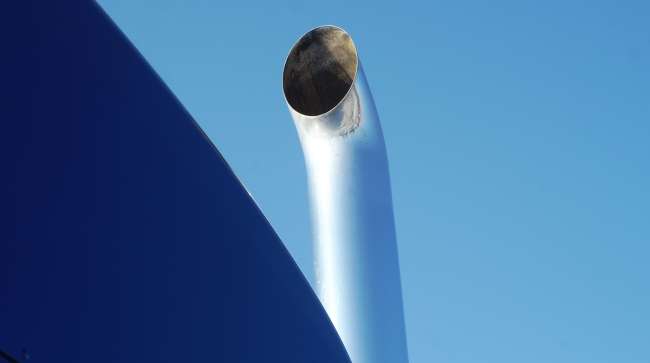Senior Reporter
Will CARB, EPA ‘Harmonize’ Their NOx Standards?

[Stay on top of transportation news: Get TTNews in your inbox.]
California regulators already have issued a proposal aimed at lowering oxides of nitrogen and particulate matter emissions for new trucks built beginning in 2024, but federal regulators are still working to craft a separate nationwide low-NOx and PM proposal scheduled to take effect in 2027.
Ideally, California Air Resources Board and U.S. Environmental Protection Agency staff hope to “harmonize” the two regulations.
But what are truckers to do if the two rules are different?
California takes bold step to reduce diesel truck pollution. A first of its kind requirement for #zeroemission trucks in the state will help communities hardest hit by #airpollution
https://t.co/ykst9l0Vi6#cleantrucks pic.twitter.com/C7BXqAF5xk — CARB (@AirResources) June 25, 2020
That’s a question that Glen Kedzie, environmental affairs counsel for American Trucking Associations, has been pondering.
“As CARB and EPA both race to the finish line in finalizing their separate regulatory approaches to address NOx emission reductions from new trucks, it remains unsettling that at this late stage in the game there still remains a lack of clarity in California’s overall approach and how it may impact national sales of low-NOx equipment in advance of a federal standard,” Kedzie said.
Late last month, CARB released a slate of proposed emissions-reduction amendments designed to keep the state’s air clean while it transitions to an all-electric truck future by 2045.
“CARB staff has been encouraging EPA to align as much as possible with our omnibus proposal, in terms of both stringency and timing,” said a CARB spokeswoman. “However, we recognize that due to federal lead time constraints, the [federal] Clean Trucks Initiative is likely to take effect approximately three years after CARB’s omnibus proposal.”
Federal documents estimate that EPA is aiming to issue the federal proposal as early as September, with the goal of issuing a final rule in July 2021, but an EPA spokeswoman said that schedule is a rough estimate.
The schedule takes into account the time needed for publication in the Federal Register, the agency to propose, conduct public hearings, receive and review public comments, data, analysis and research that are pertinent to issuing sound final actions, the spokeswoman said.
“Each action’s timing reflects a balance of time demands, resources and priorities,” the spokeswoman added.
Meanwhile, CARB plans to begin discussions on its proposed rules at its next board meeting on Aug. 27.
The amendments include:
- A proposal to reduce the current heavy-truck NOx standard from 0.20 grams per brake horsepower hour to 0.050 g/bhp-hr from 2024 to 2026, and even lower to 0.020 g/bhp-hr in 2027.
- A proposal to reduce heavy-truck particulate matter emissions from its current emission standard of 0.01 g/bhp-hr to a standard of 0.005 for 2024 and subsequent model-year engines.
- A proposal to require truck manufacturers to extend the criteria pollutant emission warranty and useful life period requirements for heavy-duty vehicles and engines. The proposed revisions require a phase-in beginning in 2027 model-year engines calling for 450,000 miles, seven years and 22,000 hours; but would be increased in 2031 to 600,000 miles, 10 years and 30,000 hours.
- A proposal to include requirements beginning in 2024 for heavy-duty on-board diagnostic systems to represent vehicle operations in real-world conditions, establishing clearer criteria for engine family pass/fail determination and on-board diagnostic data during testing to verify the condition of the test vehicle and sensors.
According to California’s emission inventory model, almost a million heavy-duty vehicles operate on its roads each year.
“These vehicles are significant sources of oxides of nitrogen, particulate matter and greenhouse gas emissions,” CARB said in a summary of the amendments. “In fact, heavy-duty vehicles comprise the largest NOx emission source category in the state, contributing to 31% of all statewide NOx emissions as well as 26% of total statewide diesel particulate matter emissions.”
For those reasons, CARB officials said that the proposed emission rule will require that new trucks still using fossil fuels have the most effective exhaust-control technology during the transition to electric trucks.
In a unanimous vote, CARB board members on June 25 approved the state’s Advanced Clean Trucks Regulation, mandating, among other things, that 5% of all Classes 7-8 trucks and 9% of medium-duty trucks sold in state be zero-emission vehicles beginning in 2024. Under the plan, the percentage of heavy-duty electric trucks sold would increase each year, topping out at 40% annually from 2032 and beyond. Medium-duty trucks would top out at 75% each year in 2035 and beyond.

How can fleet managers harness technology to get a better handle on vehicle speed and improve their safety culture? Host Seth Clevenger speaks with Mathieu Boivin of E-Smart and Jonathan Hubbard of SpeedGauge. Hear a snippet, above, and get the full program by going to RoadSigns.TTNews.com.
But in approving the electric truck mandate, the board indicted it was determined to continue reducing truck emissions and create a parallel requirement for large fleets to purchase given percentages of electric trucks to provide certainty to manufacturers in meeting their in-state sales percentages.
CARB staff also is proposing to provide manufacturers the option to certify 2024-26 model year engines to a less stringent emission standard, if they meet that standard on a nationwide basis.
“This proposed optional 50-state-directed engine emission standards would provide air quality benefits to California since federally certified trucks that travel to California would be lower-emitting than they would have been absent this option,” CARB said.
Want more news? Listen to today's daily briefing:
Subscribe: Apple Podcasts | Spotify | Amazon Alexa | Google Assistant | More




